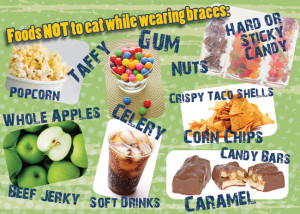Look at yearbook or prom pictures from the 1970s or ’80s and you’ll see lots of smiles sporting heavy metal braces. It’s a sight that’s rarely seen in high schools today. That’s because children today tend to get braces at a much earlier age. Some patients with special problems begin orthodontic treatment at age 7 or younger.
“The American Association of Orthodontics (AAO) recommends that all children receive an orthodontic screening by age 7,” says Dr. Horner. “Permanent teeth typically begin to emerge at age 6 or 7. It is at this point that orthodontic problems become apparent.”
“Because bones are still growing, it’s an ideal time to evaluate a child,” Dr. Horner says. “Then we can determine what orthodontic intervention, if any, may be needed either now or in the future.”
Braces Can Be Fun
To make braces more fun for young people, manufacturers have made brightly-colored elastic bands. These are the small rubber bands that hold the wires to the braces. Children can choose elastics with their school colors or a holiday color scheme, such as orange and black for Halloween.
Choosing the color of the elastics allows patients to personalize their braces, making them more fun and stylish.
Getting Used To Braces
Braces today are less uncomfortable and less visible than they used to be. But they still take some getting used to. Food can get caught around brackets and in wires, and flossing and brushing can take more time. Sometimes the teeth may be a little sore, after an adjustment. Tooth discomfort can be alleviated with the use of a pain reliever, such as ibuprofen (Advil, Tylenol and others) or aspirin. The use of lighter and more flexible wires has greatly lessened the amount of soreness or discomfort during orthodontic treatment.
As more and more children get braces, nicknames such as “tin grin” and “metal mouth” are heard less often. Because treatment has become more socially acceptable, embarrassment may be less of a concern.
Braces (And More)
Orthodontic treatment in young children is known as interceptive orthodontics. Intervention may begin as early as age 6 or 7. At this age, the teeth are still developing. The jaw is still growing. That means certain conditions, such as crowding, may be easier to address.
Before permanent teeth come in, it may be possible to help teeth to erupt (emerge through the gums) into better positions. It’s common, for example, for the dental arch to be too small to fit all of the teeth. A few decades ago, the solution for crowding was almost always to extract some of the permanent teeth to make space. Then fixed braces were used to position the teeth properly.
Early intervention takes advantage of the fact that a child’s jaw is still growing. For example, a device called a palatal expander may be used to expand the child’s upper dental arch. Once the arch is the proper size, there’s a better chance that the adult teeth will emerge in better position. Sometimes teeth still may be crowded after all of them have erupted. In such cases, some permanent teeth may still have to be extracted to make room to properly align the teeth.
Early treatment also may be beneficial when the dental arches and jaws are not in the correct position. Functional appliances may fix or improve these problems. More treatment usually is needed later on, but it may be shorter and less involved.
It is important to note that early treatment does not apply to all orthodontic problems. However, it may help in certain cases.
Two conditions that require early intervention are crossbites and protruding front teeth. A crossbite can cause the jaws to grow unevenly. Front teeth that stick out may be fractured or injured in an accident, such as a fall.
Please check back in with our blog regularly and we’ll update with common issues, questions, and answers related to orthodontic treatment.

